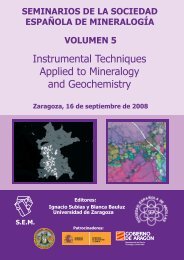XVI Reunión CientÃfica de la Sociedad Española de Arcillas - Libro ...
XVI Reunión CientÃfica de la Sociedad Española de Arcillas - Libro ...
XVI Reunión CientÃfica de la Sociedad Española de Arcillas - Libro ...
You also want an ePaper? Increase the reach of your titles
YUMPU automatically turns print PDFs into web optimized ePapers that Google loves.
Comunicaciones SEA 2001 – Baeza (Jaén)<br />
SOCIEDAD<br />
ESPAÑOLA DE ARCILLAS<br />
RELATIONSHIP BETWEEN WALL FORMATION RATE AND<br />
FILTRATION RATE IN KAOLINS<br />
Ferraz E a , Coroado J a , Gomes C a , Marques J c , Rocha F a<br />
a<br />
Dpto. <strong>de</strong> Geociencias. Universida<strong>de</strong> <strong>de</strong> Aveiro. Portugal.<br />
b<br />
Instituto Politécnico <strong>de</strong> Tomar. Esco<strong>la</strong> Superior <strong>de</strong> Tecnologia <strong>de</strong> Tomar. Portugal.<br />
c<br />
Centro Tecnológico da Cerâmica e do Vidro. Coimbra. Portugal.<br />
The Wall Formation Rate is a parameter of paramount importance in<br />
whiteware ceramics. However its assessment do not provi<strong>de</strong>, in many cases,<br />
reproducible values. The goal of the present work is to corre<strong>la</strong>te the Wall<br />
Formation Rate (WFR) with Filtration Rate (FR) for several commercial kaolins.<br />
FR is a simple and efficient parameter that can be achieved rapidly and without<br />
ambiguity using a filter press.<br />
Our proposal is to rep<strong>la</strong>ce, in industrial p<strong>la</strong>nts, the WFR method by the FR<br />
method, in or<strong>de</strong>r to have a procedure able to yield reproductive FR values directly<br />
proportional to WFR values.<br />
The experimental results herein disclosed show a very good positive linear<br />
corre<strong>la</strong>tion (R 2 =0.97) between WFR and FR methods.<br />
Introduction<br />
For WFR <strong>de</strong>terminations a p<strong>la</strong>ster mould was used. WFR is a parameter<br />
commonly used in whiteware ceramics, however experience points out for several<br />
problems, such as: maximum number of p<strong>la</strong>ster use (as a rule, 30-40); water<br />
saturation (even after p<strong>la</strong>ster drying at low temperature); saturation of fine pores<br />
by the slip casting; and the difficulty of dismoulding due both to the wrinkles and<br />
the rugosities formed in the mould bottom.<br />
For FR <strong>de</strong>terminations a filter press apparatus was used that avoids the<br />
inconveniences referred to for WFR <strong>de</strong>terminations.













